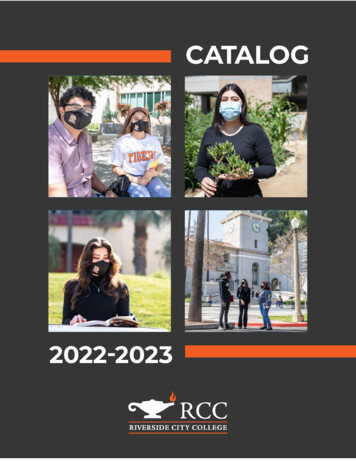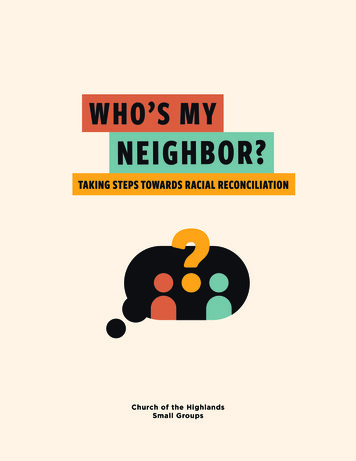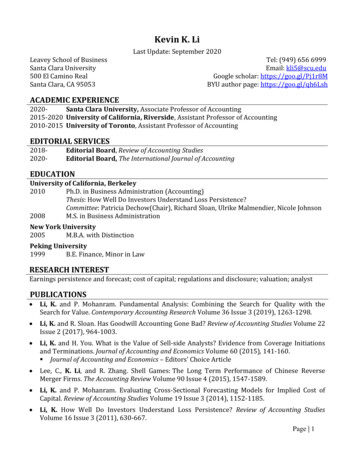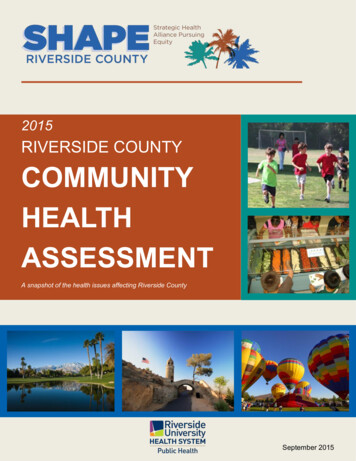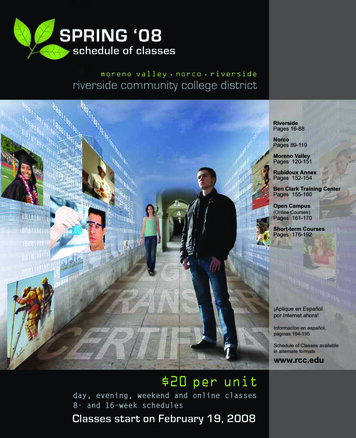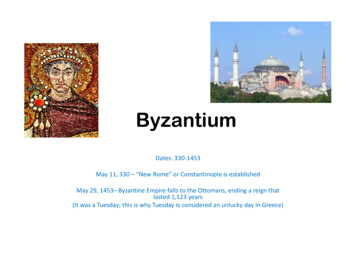
Transcription
ByzantiumDates: 330‐1453May 11, 330 – “New Rome” or Constantinople is establishedMay 29, 1453– Byzantine Empire falls to the Ottomans, ending a reign thatlasted 1,123 years(It was a Tuesday; this is why Tuesday is considered an unlucky day in Greece)
Ch. 8 ‐ Late Antiquity Look at The Life of Jesus in Art Learn these stories & images! As we moveinto Medieval, Renaissance and Baroquesociety, these will be the main images we willdeal with. New images will be introduced, variations ofthe same image will occur, but this list makesup a significant portion of what is to come.
Constantinople Current name: IstanbulLanguages: Latin; after 640 AD Koine GreekReligion: Christianity and later Eastern OrthodoxConstantinople was founded by Constantine I in 330. It sat at the entrance to theBlack Sea, was along the path of the silk road and lay at the crossroads betweenAsia and Europe.During the 6th century Justinian I became emperor and would have a lastinginfluence in both the East & West. He decorated Constantinople with beautifulmonasteries and churches such as the Hagia Sophia and the Church of HolyWisdom. In the West, he decorated Ravenna with the mosaics found at San Vitale.Constantinople survived attacks from barbarian invasions in the 5th century, theAvars and Bulgars in the 7th century and was able to hold off the Persians andArabs for hundreds of years. This helped the Roman Empire and the rest of Europegrow and flourish without the worry of invading armies from the Middle‐East.The fall of Constantinople also attributed greatly to the Renaissance. Greekscholars fled to Italy and brought with them Greek manuscripts, and knowledge ofthe classical Greek literature. This work had previously been lost for centuries inthe West in what is known as The Dark Ages.
Late Antiquity(Early Byzantine,527‐726)Justinian as the triumphantvictor.Historical document, has thename of Frankish kingsinscribed on the back.Combination of Classical &Christian figures.Justinian as world conqueror(Barberini Ivory), mid 6th century
Terminology Narthex – entrance/lobby, at the end of the nave Nave – central & principal part of a Christian church Altar – an elevated place where offerings/sacrifices aremade/religious rites Latin Cross Plan (vs. Greek Cross Plan) Longitudinal plan (vs. Central plan) Mosaic – small pieces of glass (tesserae) use to create animage
Sant’Apollinare inClasseSaint , cross of Constantine(with image of Christ incenter), prophets Elijah andMoses, hand of God, 3 sheepsymbolizing 3 disciplesSaint Apollinarisamid sheep, apsemosaic,Sant’Apollinare inClasse, Ravenna,Italy, ca. 533‐549
San Vitale Located on the Adriatic coast of Italy. Church was begun in 527 while Italy was ruledby the Ostrogoths.– Only church built during Justinian I’s reign thatstands virtually the same as when it was built. One of the most elaborate buildings decorated inthe early Christian Byzantine style in the West.– Mostly mosaics. It is the largest and best preservedoutside of Constantinople.– Mostly Old Testament figures/stories.– Panels depicting Justinian and Theodora.
San Vitale,Ravenna (Italy)Aerial view of San Vitale (looking northwest),Ravenna, Italy, 526–547.
Interior of San Vitale (looking from the apse into the choir), Ravenna, Italy, 526–547
Choir and apse of San Vitalewith mosaic of Christbetween two angels, SaintVitalis, and Bishop Ecclesius,Ravenna, Italy, 526–547.
Justinian, Bishop Maximianus, and attendants, mosaic on the north wall of the apse, SanVitale, Ravenna, Italy, ca. 547.The clergy is on Justinian’s left, soldierson the right. Justinian is centered to emphasize he is the leader ofChurch and State. He also appears Christ‐like with the halo
Theodora and attendants, mosaic on the south wall of the apse, San Vitale, Ravenna, Italy, ca.547.She is shown with jewels, crown and a golden halo;she appears goddess‐like. It shows the women goinginto the church
Hagia SophiaPlan (top) and restored cutaway view (right) ofHagia Sophia, Constantinople (Istanbul),Turkey, 532‐537
Aerial View, Hagia Sophia
PendentiveInterior of HagiaSophia (lookingsouthwest),Constantinople(Istanbul), Turkey,532–537
Transfiguration of Jesus, apse mosaic, Church of the Virgin, Monastery of Saint Catherine,Mount Sinai, Egypt, ca. 548–56Jesus became radiant, spoke with Moses and Elijah, and was called "Son" by a voicein the sky, assumed to be God the Father. It is one of the miracles of Jesus mentioned inthe Gospels of Matthew, Mark and Luke.
IVORY CARVINGSThrone of Maximianus, ca. 546–556Saint Michael the Archangel, right leaf of a diptych,early 6th century.Angel w/wings Greek/Roman personification of Victory.Michael carries the orb & cross vs the traditional palmbranch. Shown in classical drapery, rejecting rationality andnaturalism. Floats in space, free from material world.
MANUSCRIPTSAscension of Christ, folio 13verso of the RabbulaGospels, from Zagba, Syria,586
Crucifixion and Resurrection,folio 13 recto of the RabbulaGospels, from Zagba, Syria, 586
Rabbula Gospels The crucifixion takes place against a backgroundof blue mountains (Gareb and Agra). The sunwith the eye in the upper part (left) and themoon (right) appear on each side of Christ forthis is the hour of darkness and light.Near the cross of Christ 3 soldiers gamble for hisclothes.Jesus is depicted in full royal garments, theSyriac writing on the tablet declares: "This is theKing of the Jews."To the left of Christ is Longinus holding the lancewhich pierced the side of Jesus. The man withthe sponge on the right side is Steaton who laterconverted and was martyred.To the far right are the 3 women who stood atthe cross of Jesus: Mary Magdalene, Salome andMary the wife of Clopas.Dimas the good thief (viewer's left but Christ'sright) with his head bent toward Christ ispenitent and seeking God's mercy. TheScriptures recount him saying: "Lord, rememberme when you come into your kingdom." Towhich Jesus responded: "This day you will bewith me in paradise." Gestas, the unrepentantthief on the right, has an upturned and proudface. The mark near his lip may indicate an evilspirit.Standing near the cross of Dimas is Christ'smother Mary with raised hands covering hertormented face. The Apostle John sufferssilently as he looks on with desolate eyes.
Rabbula Gospels The resurrection scene in the lower half of the iconactually includes 3 distinct scenes: the empty tomb(Mt 28,2), the women carrying fragrantointment(left‐Mt 28,1), and the appearance ofJesus to the women on the road to Jerusalem(right‐Mt 28,9).The resurrection scenes are dominated by plushgreenery which suggests the new life ofresurrection.The empty tomb in the shape of a small temple(center) is supported with 2 pink columns to form 2brackets in the shape of lion's muzzles. The artisthere suggests that the jaws of death cannot containChrist. The 3 fearful soldiers are held back from thetomb by 3 rays of light seen radiating from thetomb.On the left, an angel, carrying a wanderer's staff,sits on the stone, and talks to the womenapproaching the tomb. The first woman dressed ina royal purple mantle and with a halo alludes to theMother of Christ. She is holding an alabaster jar; thesecond woman holds a smoking, cube‐shapedcenser.On the right side, these same women kneel beforethe Risen Lord.
Iconoclasm 726‐843 ADIconoclasm, an ancient Greek word that means "image‐breaking," refers tothe religious doctrine that forbade the veneration of images (icons) ofChrist and the saints in Christian churches.– Iconoclasts: breakers of images– Iconophiles: lover of imagesIn 726 AD, Emperor Leo III ordered the image of Christ at the ChalkePalace in Constantinople to be destroyed. In the following years, othermeasures were taken to suppress the veneration of images.Empress Theodora, however, presided over the restoration of iconveneration in 843 AD, an event still celebrated by the Orthodox Church asthe Triumph of Orthodoxy.The iconoclastic movement was motivated by a variety of factors thatpossibly included foreign influences, as well as the concern that the cult oficons was a form of idolatry. The Council of Nicaea (325) also specifiedthat images should be venerated but not worshipped, since worshipbelongs to God alone and the worship of icons would mean idolatry.Images that survive from this period were preserved at the Monastery ofSt. Catherine, Mt. Sinai.
Virgin (Theotokos) and Child between SaintsTheodore and George, icon, 6th or early 7th centuryChrist blessing, icon, 6th century
The restoration of images began in843.Mural painters, mosaicists, bookilluminators, ivory carvers & metalworkers began to receive numerouscommissions (leading into what isoften referred to as Middle ByzantineArt, 843‐1204)It is in Byzantine Art thatimages of the Virgin Marybecome popular and beginto be included in Christianchurches and iconography.Virgin (Theotokos) and Child enthroned, apsemosaic, Hagia Sophia, Constantinople(Istanbul), Turkey, dedicated 867
Interior of Katholikon (monastery’s main church, looking into the dome),Hosios Loukas, Greece, first quarter of 11th century
Crucifixion, mosaic inthe Church of theDormition, Daphni,Greece, ca. 1090–1100
6th century11th century9thcenturyNotice the gradual strengthening of emotional expression. Figures seem to be coming morealive emotionally, figures dramatize their emotions with gestures and their facial expressions.
Christ as Pantokrator, domemosaic in the Church of theDormition, Daphni, Greece,ca. 1090–1100Pantokrator – ruler of all;almighty, all powerfulThis is an example of thedeveloping expressionism thatis found in later MiddleByzantine Art.
Byzantium in the West Byzantine art continued to flourish until c. 13th century; overlapswith the Proto-Renaissance.– 4th Crusade (1204) sacked Constantinople, 800 years ofcontinuous Byzantine culture was interrupted.– Palaeologan Dynasty saw the last flourish in Byzantine Art,partly because of an increasing cultural exchange betweenByzantines and Italians.– Mosaics eventually gave way to frescoes.In architecture, churches varied between the central andlongitudinal plans.– One deviation is St. Mark’s Cathedral in Venice which is in theGreek-Cross plan. Here, the focus is on the dome.– Relics of St. Mark stolen from Alexandria, Egypt and taken toVenice, Italy in 828. Original church (later burnt down) dates tothe 9th c. The present one started in 1063.
St. Mark’s Basilica, Venice (Italy)Church ofThe HolyApostles,12th c MSreproduction
Detail, façade of St. Mark’s Basilica, Venice, Italy
Façade mosaic, depicts the procession bringingSt. Mark’srelics to Venice.
Interior of Saint Mark’s(looking east), Venice, Italy,begun 1063
Empress Irene, detail of the Pala d’Oro, Saint Mark’s, Venice, Italy, ca. 1105Pala d’Oro ‐ behind the altar at the Basilica di San Marco; altar screen.‐ It’s a gold, enamel and jewel‐encrusted altarpiece made in Constantinople for Doge Pietro Orseolo I in976. It was then enriched and reworked in Constantinople in 1105, enlarged by Venetian goldsmiths in1209 and reset in the 14th century.‐ Among the almost 2000 stones that decorate it are 526 pearls, 320 emeralds, rubies, amethysts,sapphires, jasper, topaz and coralline
SicilyPantokrator, Theotokos and Child,angels, and saints, apse mosaic in thecathedral at Monreale, (Sicily) Italy, ca.1180–1190.
Interior (looking west) ofthe Cappella Palatina,Palermo, Sicily, begun1142
Ivory Carving ‐ Christ enthroned with saints (Harbaville Triptych), ca. 950
MelodyPaintingEchoMan represents themountain of Bethlehem(notice he is pointing to aninscription)David composing the Psalms,folio 1 verso of the Paris Psalter,ca. 950–970Allegorical ‐ a symbolicrepresentation of something
Lamentation over the dead Christ, wall painting, Saint Pantaleimon, Nerezi,Macedonia, 1164
Late Byzantine Art1261‐1453Christ as Savior of Souls,icon from the church ofSaint Clement, Ohrid,Macedonia, early 14thcentury
Anastasis, apse fresco in the parekklesion of the Church of Christ in Chora (now theKariye Museum), Constantinople (Istanbul), Turkey, ca. 1310–1320.
Anastasis (Resurrection) frescoin the parekklesion of the ChoraChurch, 1310‐1320Parekklesion‐ mortuary chapel forfamily burials and memorials.
Large sakkos ofPhotius, ca. 1417. Satinembroidered with goldand silver thread andsilk with pearlornament
Annunciation, reverse oftwo‐sided icon from SaintClement, Ohrid,Macedonia, early 14thcentury
Three angels (Old TestamentTrinity), ca. 1410
Saint , cross of Constantine (with image of Christ in center), prophets Elijah and Moses, hand of God, 3 sheep symbolizing 3 disciples Saint Apollinaris amid sheep, apse mosaic, Sant'Apollinare in Classe, Ravenna, Italy, ca. 533‐549
